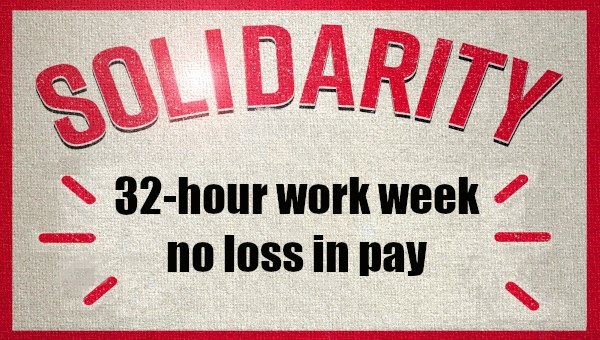Low Pay and a Four-Day Workweek
Dolly Parton’s signature song “9 to 5,” and the 1980s sitcom of the same name reflect a quintessentially American hustle culture of working 40 hours a week in thankless jobs. Even though many people work even more than that – earning the US the title of “the Most Overworked Developed Nation in the World” – our expectations of the ideal work scenario are built on a hard-fought labor victory, one that was still not nearly enough to curb worker exploitation.
In 1926, Henry Ford instituted a 40-hour workweek for his auto factory employees, perhaps because he truly believed workers needed more time for rest and leisure, but also because he expected they would be more productive if they worked less. The move paid off for Ford’s bottom line and also helped shift national culture toward working fewer hours.

5,000 Strikes
A decade later, auto workers at General Motors in Flint, Michigan, went on strike protesting terrible working conditions. The 1936 labor action came to be known as “the strike heard around the world,” and in February 1937, General Motors conceded to worker demands, sending a powerful message across the nation that worker-led strikes can win. In 1937, about 1.9 million Americans participated in nearly 5,000 strikes – considered the most seminal year in US labor history.
It’s no wonder then that a year later, President Franklin D. Roosevelt signed the Fair Labor Standards Act of 1938 imposing a minimum wage of 25 cents an hour and a 44-hour workweek, as well as overtime pay. Two years later, in 1940, that act was amended to further reduce work hours to 40 per week. That should have been the beginning, not the end of improved labor conditions. The biggest failure of the Fair Labor Standards Act was that it did not link the minimum wage to inflation.
Now, more than 80 years later, Congress is considering a 32-hour workweek. Representative Mark Takano (D-CA), with the support of major labor unions like SEIU, introduced a bill in the House of Representatives to reduce the workweek to four days.
While on the surface a welcome move for labor rights, the problem is that unless corporate employers are forced to give people the same (or greater) annual take-home pay and preserve benefits, moving to a four-day workweek may not amount to much. According to a 2018 Economic Policy Institute report, because wage growth remained stagnant, “For most workers… annual earnings growth has been driven by their ability to work more hours.” Why would workers desire a reduction in work hours if it meant taking home less pay?
A recent Washington Post-Ipsos survey found that three-quarters of those polled preferred working 40 hours over four days – that is 10-hour days – to working 40 hours over five days. And, nearly as many said they would prefer working 40 hours over five days rather than lose a fifth of their salary. This is hardly surprising.
Strangely the poll did not ask whether workers would prefer working 32 hours over four days with no reduction in pay. Is it because the pollsters knew that reducing work hours without reducing pay would be so popular that it wasn’t worth asking? Or was it that corporate employers would consider such a question to be the height of worker hubris? By leaving out the question the pollsters tacitly embraced corporate profit-driven values.
Reduced Work Hours with No Loss in Pay
Casting the idea of reducing work for the same pay as a novel notion, the Washington Post said, “[S]ome advocacy groups are pushing through pilots for a 32-hour, four-day workweek without decreasing pay.” The paper immediately followed that with corporate talking points: “Hurdles including concerns about staffing, lower productivity, increased costs, and complex changes to operations are keeping the shortened workweek from being widely adopted.” There was no mention of who views increased costs as “hurdles.”
The US economy, valuing worker productivity in service of corporate profits over all else, has continued to push cultural attitudes toward more work, not less, with papers like the Washington Post doing their part. While 40 hours a week may be part of the cultural fabric, an unwritten rule of corporate America is that in exchange for job security, one is expected to work 60 or more hours a week.
Indeed.com’s pros-and-cons list of a 60-hour workweek opens with the sentence, “Working 60 hours a week can be one way to earn a higher salary, while also proving your dedication to your job and the company.” Further, with the rise of the gig economy, a significant number of workers in low-wage jobs have had to rely on unreliable work hours, low pay, and no benefits. They might work 9 to 5, or 5 to 9.
This economic status quo also fuels a stubborn gender pay gap. This year Equal Pay Day fell on March 14, which means that women would have had to work an extra three and a half months to make as much money as men did in 2022. For Black women, it falls far later, on September 21, 2023. A new study published by the American Sociological Association concluded that men’s overwork is contributing significantly to this gap. “The overwork effect on trends in the gender gap in wages was most pronounced in professional and managerial occupations,” said the study’s authors, “where long work hours are especially common and the norm of overwork is deeply embedded in organizational practices and occupational cultures.”
Gender Wage Gap
Merely reducing work hours will not close the gender wage gap. It might even increase if women take on extra housework on their day off while men work extra jobs. In her new book The Good Enough Job, author Simone Stolzoff pointed out that, “Despite gains in wealth and productivity, many college-educated Americans – and especially college-educated men – have worked more than ever. Instead of trading wealth for leisure, American professionals began to trade leisure for more work.”
There’s a move to change US culture to relinquish our attachment to work. Stolzoff’s book is one of several urging Americans to work less. In her new book Saving Time: Discovering a Life Beyond the Clock, best-selling author Jenny Odell views the current economic structures that we operate in as having arisen from European colonial culture. She urges people to reimagine our relationship with our time.
But is it that we are all trained to want to work, or that we don’t have the luxury to choose leisure? The problem is that overall pay is still so low compared to the cost of living that those who can work more – perhaps because they have partners willing to do more child care and housework – do so, earning overtime pay to ensure that their household’s needs are met. A four-day workweek is likely to do the same, freeing up an extra day merely to work more in a second job or take on more childcare or housework.
Trials of a four-day workweek by some companies have shown this is precisely what is happening. Some corporate heads love the idea of reducing work hours and salaries and are happy to have their workers take on side jobs to make up for the loss in salary on their day off. “[W]e believe that we’re providing value through flexibility,” said one startup CEO to Business Insider as justification for lower salaries. Another CEO touted how one of her employees now has the free time to work side jobs like Spanish translation and bartending.
If a four-day workweek comes with pay that’s still not enough to live well, then it is merely offering workers the freedom to work less in order for them to work more elsewhere. What is the point? The federal minimum wage remains stuck at an appallingly low $7.25 an hour, with tipped workers surviving in serfdom at $2.13 an hour.
I am writing this weekly column on my day off from a four-day job that pays a decent wage but is still not enough to provide for all my household expenses, and it is certainly not as much as my male spouse earns. To be fair, my main employer reduced work hours without reducing my salary – a wonderful step in the right direction. But the problem, again and again, is low pay. While I love writing a weekly column, I do it for the meaningful joy it brings and for the compensation. It’s a side hustle.
When Representative Takano was asked about the barriers to realizing his bill for a 32-hour workweek, he addressed the potential loss of pay by saying that, “We also have to pay attention to the ability of workers to unionize to bargain for higher wages.” In other words, workers and their unions (that is, if they are lucky enough to be among the minority of Americans represented by labor unions) have to fend for themselves in ensuring a living wage.
Senator Bernie Sanders has joined the call for a 32-hour workweek, emphasizing that such a move should come with “no loss of pay.” But even if that happened, wages still remain too low to live on and most workers might spend their free time on side hustles, like I do.
If workers were paid a minimum of $100 an hour (not unlike what most corporate executives get paid) and had the choice to work a 32-hour week versus a 40-hour week, I believe most would choose the former.
“It’s a rich man’s game no matter what they call it,” sang Dolly Parton. The real problem of overwork is underpay. •
This article was produced by Economy for All, a project of the Independent Media Institute.




